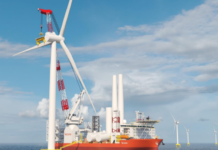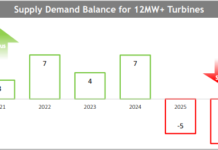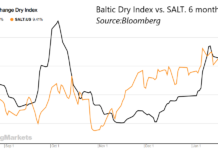Wind advocates like to say "The wind’s always blowing somewhere" to counter concerns about the variability of wind power. This is true, and it means that wind can always be relied on to produce some power, but that does not mean that wind can always meet demand. In the United States’ Great Plains wind belt, wind is typically anticorrelated with demand, meaning that, unless we can shift demand to times when the wind is strong, either through time of use rates or demand planning, overall energy production from wind will not be able to exceed 25-35% of overall demand without completely overwhelming the system when demand is low and the wind is strong.
However, even getting to 25% will be tricky without careful planning and a more robust transmission grid which will be capable of bringing wind power from where wind happens to be blowing (which could be hundreds of miles away in any direction) to where it is needed, or by investing in more expensive grid-based storage.
Potential for Low Variability
Lena Hansen and Bryan Palminter at the Rocky Mountain Institute, and Jonah Levine at CU Boulder have been doing some excellent work to show that portfolio theory can inform how to optimally combine a diversified portfolio of wind and solar sites to dramatically reduce the overall variability of a combined wind-solar portfolio.
 |
 |
| Source of Images: Spatial and Temporal Interactions of Solar and Wind Resources in the Next Generation Utility |
This demonstration goes a long way towards alleviating concerns about any unreliability concerns for wind or solar, but answering that one question leads to another: Are we actually getting anything like an optimal wind/solar portfolio?
Overly Concentrated Portfolio
The answer to that question is unfortunately, "no." Current incentives for wind, such as the production tax credit (PTC) and state Renewable Electricity Standards (RES) both reward energy produced, not the true economic value of energy produced. The PTC is functionally a payment of 2.1 cents for each kWh of wind energy produced, while RES’s require that a certain percentage of energy produced come from renewable sources. An added complication is that many state RES include added incentives to produce renewable energy in-state, which reduces geographical diversity further.
This emphasis on total energy produced leads wind developers to "optimize capacity factor," according to Jim Himelic, and Associate Analyst at Xcel Energy (NYSE:XEL), the US’s largest utility seller of wind energy. Mr. Himelic spoke about Xcel’s Wind Integration project to tackle the problem I recently called the "Dumb Grid:" the fact that grid operators do not use much weather forecasting information when trying to integrate wind onto the system. This is not only from a lack of incentives and tools allowing utilities to integrate weather data, but also simply from a lack of good data. Most wind farm operators currently have no incentive to provide even turbine-by-turbine production information to grid operators, data which would be valuable for forecasting of short term wind fluctuations.
According to Himelic, because most Colorado wind capacity is clustered in the Northeast of the state, and the above incentives along with constrained transmission means that new additions to wind capacity will also likely be in the Northeast, meaning that, at least in the short term, geographic diversity is likely to decrease rather than increase over time. This both increases the overall variability of the wind resource, and will also increase the frequency and size of large wind ramp events, when power from wind turbines rises or falls extremely quickly over a very short period. The worst such ramp events from a grid operator’s perspective often come when wind speeds rise so far as to require the turbines to shut down to avoid damage. This can cause a large number of turbines to go off-line at once, leading to a quick drop in overall power production.
Concentrating a majority of wind farms in a small area means that such wind over-speed events are likely to affect many farms at once, exacerbating the problem for grid operators.
A Gust of Hope
It’s ironic that government incentives for renewable energy are adding truth to wind’s only partially deserved reputation for unreliability. Fortunately, recent changes in national policy may help to alleviate some of the pressure to cluster wind farms in small areas.
First, wind developers now have the option to take a 30% Investment Tax Credit (ITC), comparable to the one available for solar, rather than PTC. This has the advantage that wind developers receive a portion of their investment costs back, independent of total production, which will reduce some of the disincentive to build wind farms at relatively low capacity factor sites. Similarly, a national RES would be unlikely to encourage local production of renewable energy, which might improve wind diversity.
Tom Konrad, Ph.D.
DISCLOSURE: None.
DISCLAIMER: The information and trades provided here are for informational purposes only and are not a solicitation to buy or sell any of these securities. Investing involves substantial risk and you should evaluate your own risk levels before you make any investment. Past results are not an indication of future performance. Please take the time to read the full disclaimer here.








One excellent paper that covers the issue of effective load carrying capacity of large scale wind in the continental US is the DeCarolis and Keith study. No doubt this is nothing new for you, Tom, but here is the reference if other readers would like to read a thorough study on the costs of wind meeting demand. Quite high percentages of wind alone can be accomodated without storage.
It would be interesting to see a similar analysis done with different amounts of solar included to see the effects.
http://www4.ncsu.edu/~jfdecaro/decarolis_EPwind.pdf
I have not seen this particular study, although it looks interesting. I caution readers that this older paper does not deal with all wind integration costs, and hence may come to some flawed results. While it directly tackles the longer term variability of wind, it does not address the cost of rapid ramp-up and ramp-downs which put a strain on the system as well. As such, this paper probably underestimates the benefits of spatial diveristy. (I suspect the rapid ramp up/ramp down problem was not considered because this is paper was written in 2003 or early 2004, before that problem was widely recognized.
The paper is actually more pessimistic than more recent grid operator studies, although they were typically for total integration costs below 50% wind penetration.
Ramp-up and ramp-downs are most efficiently managed from a global total grid perspective, it’s not like all natural gas plants will be throttled down or up simultateously.
With a smart grid, the costs of ramp up and down become extremely marginal because of the role of end use small and large scale thermal storage in interruptable loads (smart refrigerators with extra cooling elements for a couple of hours of storage for example, or HVAC with a couple of tons of extra water for thermal storage). Not to mention playing around with the charge time of electric vehicles and plugin hybrids, to act as a minute-to-hour buffer. Those things could replace close to 100% of thermal generation plant ramping.
Since the efficiency gain (less system fuel use) of the smart grid alone gives it a very fast payback for the country, it is a no-brainer infrastructure that we should already have built.
Cyril,
We don’t yet have a smartgrid, and we’re not going to have one for years. Even when we do, it’s unlikly to make sense to cluster our wind farms: there are many sources of variability that smart grid technologies will need to contend with; there’s no reason to add to them.
We’re still working on defining the costs of wind integration, and they should turn out to be quite manageable, but there is no point in increasing wind integration costs by clustering wind farms too tightly.
We also don’t have a wind grid, even less a solar grid. However, it will be useful to combine these developments of smart grid and non dispatchable generation. Solar and wind are growing exponentially but grid upgrades are going painfully slow. With exponential growth, we need a proactive infrastructure strategy.
Regions with a lot of wind resource or solar resource and higher electric prices will see more wind and solar being built. So a large degree of clustering is not surprising. But these areas are also prime candidates for starting smart grid developments. When it’s proven in regional grids, expanding the smart grid into nearby grids will be easier. Then there’s only the transmission infrastructure to link these grids together to be developed.
At any rate, the study I linked to may be too pessimistic since much less clustering than four or five sites is going to happen, if you are right that clustering increases the cost rapidly at higher penetration rates.
However, I’d like to point out that there are advantages to clustering: better transmission and distribution economics with long transmission line distances. And larger windfarms are cheaper than the list turbine price because of volume discount (through increased buying power, more competitive supply contracts etc). Right now these advantages are not apparent because of the tight market (sellers market) created through rapidly increased deployment subsidies for wind (mostly climate concerns). Wind is an attractive candidate for subsidies because wind is fairly low cost so you only need a few cents/kWh subsidy to get a large deployment going. But this has created a very tight market. Once the market cools down a bit (somewhere over the next decade) I expect large windfarms to have more apparent cost advantages.
It remains to be seen what cost advantage/disadvantages weigh more in reality.
To be claer, I’m not advocating only small scale wind farms. Theres notheing wrong with 200MW or 1000MW wind farms… for diversification, however, you don’t want more than 10-20% of your wind capacity in one area.
That’s why the DeCarolis and Keith study showed that under higher wind percentages on large grids, spreading out the sites makes more and more sense.
Up to 20-30 percent or so, there’s barely any difference. I have to be honest and say this assumes flexible gas turbine and combined cycle gas turbine to complement the wind portion. The use of bio-energy and hydroelectric can help here, but on the other hand there will also be lots of coal and nuclear which can increase the cost of meeting the load with a large fraction of wind. It would be useful to do a similar study with baseload nuclear, coal and geothermal to see what the effect will be on average cost of power.